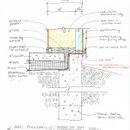Moisture Concerns in “Straw-Cell” wall in Climate Zone 4A
Hello!
I am planning a “straw cell” house (see attached drawings) and love the “Pretty Good House” criteria. I have been reading a lot about double-stud cellulose walls b/c I can’t find that much research specifically on “straw-cell,” but I figure they might behave similarly.
Details and questions below.
Thanks in advance!
Adrienne
PROJECT DETAILS:
-Location:Columbia, Missouri – northern end of Climate 4A
-Size:576 sf footprint (with 288 sf loft)
-Wall Assembly:load bearing 2x4s w/ dense pack cellulose; interior of that straw bales laid on-edge with earthen plaster on inside; zip sheathing; rainscreen siding
-ERV:1 or 2 Lunos eGO in-wall units
-Dehumidifer:one in bathroom, make & model TBD
-MEP:minisplit
QUESTIONS:
1. Is it crazy to build like this in 4A?I sense that moisture condensing on sheathing in super-thick cellulose walls is of greatest concern in colder climates (like zone 5?)
2. How significant is the lack of latex paint on the interior?Paint seems to be key in controlling vapor in double-stud-cellulose walls. Obviously, I’m not going to paint earthen plaster.
3. Would using plywood sheathing instead of Zip be advised?If so, what is most affordable liquid-applied or membrane product to air-seal the plywood?
4.I am interested in installing moisture / temp sensors in wall to measure over time (as a citizen scientist).Suggestions on products / methods for doing this?
ARTICLES ON STRAW-CELL:
http://endeavourcentre.org/2014/10/finishing-the-straw-cell-wall-system/
//m.etiketa4.com/article/straw-bale-walls-for-northern-climates
GBA细节图书馆
A collection of one thousand construction details organized by climate and house part












Replies
Hi Adrienne.
I don't know too much about straw bale construction nor natural earthen plasters, except to agree that you are correct that you will have a very vapor-open wall to the interior to consider. You might consider consulting with Chris Magwood, author of the article you linked to or perhaps Jake Bruton, a very building-science minded builder in your town, before settling on this assembly (this is Jakes company:http://www.aarowbuilding.com).
Also, look for a new article tomorrow on our homepage on paint and permeability that will be helpful to understanding the intricacies of its role in vapor control.
Dan Kolbert, who wroteA Case for Double Stud Walls, uses plywood and ZIP sheathing on his double-stud walls, but avoids commodity OSB sheathing. Many builders do prefer plywood to OSB for its ability to hold up to wetting and drying cycles. Keep in mind that you can tape or seal just the seams of the plywood and then use a more affordable mechanically-fastened WRB if you'd rather not use an expensive self-adhered or fluid-applied product.
Most of the builder I know that monitor their walls for moisture levels use Omnisense products (https://www.omnisense.com).
Brian, Thanks for that info. I have met Jake; he is very knowledgeable. I will reach out to Chris and look into your other suggestions!
I guess I am an in for a penny in for a pound guy and do not see the advantages of this hybrid 2x4 and sheeting with straw bales. If you are going to have carpenters on site to build the 2x4 walls they might as well build another wall and have a double stud wall and skip the bails or build a straw house and skip the carpenters. It seems to me the hybrid has cost more with little advantage.
One of the down sides of thick walls is property taxes. The County will measure the outside of the building and length times width equals the square footage times X number equals your taxes.
If your lot is in the city getting a permit could be tricky. If you are in the next county you will likely need a permit but no inspections for anything but the septic.
My wild guess is if you are willing to run the ERV and can get the winter humidity close to 30% the dehumidifier will not be needed after the first winter or two.
This group is about an hour from Columbia MO and has occupied a straw home since 1994. They have a workshop in July maybe. Sorry I just noticed the year on the website is 2017.
http://silverseedfarms.com/straw-bale-cob-earth-plaster.html
Walta
Assuming your house is a 24' square, you'll have 96 linear feet of straw bales. Most bales are around 16-18" thick. You'll use up a hefty fraction of living space with straw. A house that small, in zone 4A, will be pretty easy to heat no matter what. I'd skip the straw entirely. Maybe use ZipR6 for extra R and air tightness?
Walter & Stephen - Thanks for your thoughts. I am aware straw-cell is more insulation / space / cost than other methods. But, I am interested in it for other reasons, too: carbon sequestration, aesthetics of interior plaster, local material...etc. Double-stud with cellulose is my "plan B" :-)
Adrienne,
I am interested in the straw-cell approach for similar reasons. Did you end up going this way? how did it work out? I am having trouble finding details online, for example showing how plumbing and electrical are done with the straw-cell wall. Thank you!